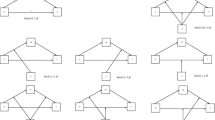Abstract
The issue of sensitivity of the structural equation modeling (SEM) methodology to violations of the underlying hypothesis of linear latent relationships is the focus of this paper. The identity of overall goodness-of-fit indices of an initially considered linear latent pattern model and of an equivalent model not making this assumption exemplifies the lack of routinely available global means within the methodology to evaluate the linearity assumption. It is next focused on the sensitivity of SEM to violations of presumed linearity for a general, nonlinear pattern of true relationship. The results of a simulation study are then presented which demonstrate that latent correlations and percentage explained variance as well as parameter standard errors and model residuals can provide critical information about violation of latent linearity, and should therefore also be focused on when examining departures from linear relationships at the latent level in applications of the SEM methodology in social and behavioral research.
Similar content being viewed by others
References
Arminger, G. & Schoenberg, R.J. (1989). Pseudo maximum likelihood estimation and a test for misspecification in mean and covariance structure models, Psychometrika 54: 409–425.
Bentler, P.M. (1993). EQS. Structural Equations Program Manual, Los Angeles, CA: BMDP Statistical Software.
Bollen, K.A. (1989). Structural Equations with Latent Variables, New York: Wiley.
Breckler, S. (1990). Applications of covariance structure modeling in psychology: Cause for concern? Psychological Bulletin 107: 260–273.
Browne, M.W. & Arminger, G. (1995). Specification and estimation of mean-and covariance-structure models, in G. Arminger, C.C. Clogg, & M.E. Sobel (eds.), Handbook of Statistical Modeling for the Social and Behavioral Sciences, New York: Plenum Press, pp. 185–250.
Browne, M.W. & Cudeck, R. (1993). Alternative ways of assessing model fit, in K.A. Bollen & J.S. Long (eds.), Testing Structural Equation Models, Beverley Hills, CA: Sage, pp. 136–162.
Burkill, J. C. & Burkill, H. (1970). A Second Course in Mathematical Analysis. London: Cambridge University Press.
Duncan, O.D. (1969). Some linear models for two-wave, two-variables panel analysis, Psychological Bulletin 72: 177–182.
Duncan, O.D. (1975). Introduction to Structural Equation Models, New York: Academic Press.
Joreskog, K.G. & Sorbom, D. (1988). LISREL 7: A Guide to the Program and its Applications. Chicago, IL: SPSS Scientific Software.
Joreskog, K.G. & Sorbom, D. (1993a). PRELIS 2: User's Guide. Chicago, IL: SPSS Scientific Software.
Joreskog, K.G. & Sorbom, D. (1993b). LISREL 8: User's Guide, Chicago, IL: SPSS Scientific Software.
Joreskog, K.G. & Sorbom, D. (1993c). LISREL 8: The SIMPLIS Command Language, Chicago, IL: Scientific Software.
Lee, S. & Hershberger, S. (1991). A simple rule for generating equivalent models in covariance structure modeling, Multivariate Behavioral Research 25: 313–334.
Lord, F.M. & Novick, R. (1968). Statistical Theories of Mental Test Scores, Readings, MA: Addison-Wesley.
Luijben, T.C.W. (1991). Equivalent models in covariance structure analysis, Psychometrika 56: 653–665.
MacCallum, R.C. (1986). Specification searches in covariance structure modeling, Psychological Bulletin 100: 107–120.
MacCallum, R.C., Wegener, D.T., Uchino, B.N., & Fabrigar, L.R. (1993). The problem of equivalent models in applications of covariance structure analysis, Psychological Bulletin, 114: 185–199.
Pedhazur, E.J. (1982). Multiple Regression in Behavioral Research. Explanation and Prediction, New York: Harcourt Brace Jovanovich.
Raykov, T. (1993). A structural equation model for measuring residualized change and discerning patterns of growth or decline, Applied Psychological Measurement 17: 53–71.
Raykov, T. & Widaman, K.F. (1995). Issues in applied structural equation modeling, Structural Equation Modeling 2: 289–318.
Rogosa, D.R. & Willett, J. (1985). Satisfying a simplex structure is simpler than it should be, Journal of Educational Statistics 10: 99–107.
Stelzl, I. (1986). Changing a causal hypothesis without changing the fiu Some rules for generating equivalent path models, Multivariate Behavioral Research 21: 309–331.
Author information
Authors and Affiliations
Rights and permissions
About this article
Cite this article
Raykov, T., Penev, S. Structural equation modeling and the latent linearity hypothesis in social and behavioral research. Quality & Quantity 31, 57–78 (1997). https://doi.org/10.1023/A:1004269215766
Issue Date:
DOI: https://doi.org/10.1023/A:1004269215766




